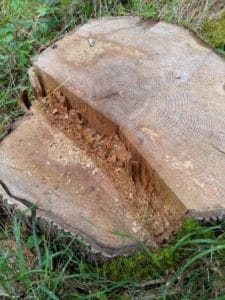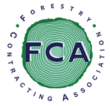
Felling diseased ash requires extra care be taken over and above the usual considered for hardwood working. It’s easy to look at ash as a tricky tree to fell but well within the capabilities of any experienced cutter. I found out the hard way that diseased ash presents a different set of challenges.
It was one of the trees I felled towards the end of last summer that almost caught me out. I had a tree on the edge of a stand of spruce to take down as it was on the side of a track used by estate staff to cross a stream where there is an old bridge. I noticed the chips were dirty and had an odd odour. They were brown, not the white turning to pink you would normally expect. I had to miss a beech tree that was standing just to the side and right of where the natural lean of the ash would take it. I was felling using a 25” bar and it needed all the length of the bar plus a little bit to get a good hinge which I’d set to take the tree past the beech and onto the track. I finished the cut and the tree began to move. It started perfectly but after the top had moved hardly any distance it broke away and smeared the beech into firewood.
On inspection the hinge had broken along its entire length with hardly any loading, there was no pulling or ripping and the tree had simply gone where gravity had taken it. Fortunately weeks of felling ash previously had taught me enough to step back into the stand of spruce and I’d been away from the shower of pieces of branch that had been fired around as it crashed into the beech. The two of us on site that day spent the next half hour considering what had just happened and we quickly realised that single tree had been a game changer.
As we went into the autumn felling ash that were on the sides of tracks and footpaths we found many more that had the same weak hinge problem but by then we had learned how to deal with them. Consider my experiences and understand what you will eventually be faced with before you start felling diseased ash. You might find a lot of trees that present no more challenges than usual but eventually you will find trees that have been affected. Be ready, that way you won’t be surprised.
A standard felling risk assessment will require beefing up in several areas. Before you write an ash dieback specific risk assessment there are a few things you need to be aware of.
1/ Falling branchwood.
Special care is needed due to the readiness of diseased trees to drop branchwood during felling. The first action before felling is always to take a look into the crown of the tree you are about to fell and into any trees adjacent. This isn’t just a quick glance, you must make a thorough assessment before you go to the base of the tree. The basic rule is to always try to avoid felling trees past other standing trees in the crop. Fell understorey and saplings first.
Always fell front trees first and try to create a face to fell away from. Do not be tempted to fell trees through the crop. Thinning in a pure stand isn’t practical. Removing ash from a mixed crop should only be done with extreme caution and using the methods described above. Always fell away from trees being left, into an open space.
2/ Unsound timber at the stump.
If trees you are about to fell are showing clear signs of dieback ie dead twigs or branches in the crown, large clusters of dead keys or browned off leaves, it’s likely the timber where you will make your felling cuts will not be sound. Check the colour and smell of the chips when you make your first cut. Diseased wood produces a grey or brown chip with a distinct musty odour. If the wood is questionable then it’s likely you won’t be able to rely on any hinge you cut, regardless of how accurate your cuts are.
3/ Weak hinge
If the trees are affected you will need to rethink the way you fell. Accurate felling cuts are essential, there’s no margin for error if you are to have any control over the felling direction, but you won’t be able to direct diseased trees to any large degree. Felling against lean or weight bias is almost impossible. Don’t remove root buttresses, you need as much timber in the hinge as possible. The only choice is to fell trees with lean and weight bias then a small degree of directional control is possible.
4/ Felling aids
Refer to point 1. The use of wedges, jacks or hydraulic wedges is not recommended to aid felling trees that have been confirmed as having unsound timber at the stump. Trees that are still healthy or are at least in sound condition can still be felled using felling aids. Diseased trees will shed branches just from the vibration caused by hammer blows on a wedge. Diseased trees will break the hinge when being wedged or jacked over with little lifting pressure and even less warning. Pulling trees with a winch is only possible if ropes are attached as high as possible up the stem, a good thick hinge has been left and any pull is only slightly off the line of the tree’s natural lean or bias. Take extreme care when mounting ropes, always make a thorough inspection of the crown and take extra care when assessing branches lower down the stem. Even quite big branches can be brittle to the point of being unsafe.
Edge trees should be felled without any felling aids as a rule if they are showing signs of dieback. Always err on the side of caution and fell them where the weight bias and lean takes them even if it means a lot of clearing up afterwards.
Issues you’ll need to address in writing a Risk Assessment for felling diseased ash.
- Falling branchwood.
- Branches being shed from contact with standing trees during felling.
- Dead and dying trees liable to break away at the stump.
- Difficulties in creating strong hinge.
- Difficulties in maintaining control of felling direction.
- Use of felling aids only on a tree by tree basis after assessment of the tree’s condition.
- Pulling trees with a winch only on a tree by tree basis after assessment of the tree’s condition.
- Edge trees in particular can’t be wedged, jacked or winched if they have typical weight bias or lean.
